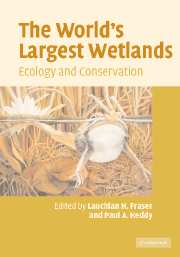Book contents
- Frontmatter
- Contents
- List of contributors
- Preface
- 1 Introduction: big is beautiful
- 2 The West Siberian Lowland
- 3 The Amazon River basin
- 4 The Hudson Bay Lowland
- 5 The Congo River basin
- 6 The Mackenzie River basin
- 7 The Pantanal
- 8 The Mississippi River alluvial plain
- 9 The Lake Chad basin
- 10 The River Nile basin
- 11 The prairie potholes of North America
- 12 The Magellanic moorland
- 13 The future of large wetlands: a global perspective
- Index
- References
1 - Introduction: big is beautiful
Published online by Cambridge University Press: 10 August 2009
- Frontmatter
- Contents
- List of contributors
- Preface
- 1 Introduction: big is beautiful
- 2 The West Siberian Lowland
- 3 The Amazon River basin
- 4 The Hudson Bay Lowland
- 5 The Congo River basin
- 6 The Mackenzie River basin
- 7 The Pantanal
- 8 The Mississippi River alluvial plain
- 9 The Lake Chad basin
- 10 The River Nile basin
- 11 The prairie potholes of North America
- 12 The Magellanic moorland
- 13 The future of large wetlands: a global perspective
- Index
- References
Summary
This book actually requires no introduction. The title says it all. You may therefore safely turn to the chapters dealing with each wetland. If you are curious about the tale behind the title, and wish to read further here, the tale is largely the search for scientific and conservation priorities. To succeed at scientific research or conservation action, clear priorities must be set – there are always vastly more scientific questions, and vastly more conservation problems, than humans can solve. One way to prioritize is by size: if we can identify the big scientific problems or the big conservation issues, we can address them first. This may appear self-evident, but often it seems that it is not.
No two editors can restructure conservation bureaucracies or scientific communities. However, a clear snapshot of the state of global wetlands, could, we believe, have such an effect. By highlighting all the world's largest wetlands in one book – wetlands that range across ecosystem types, international boundaries, and styles of research – we aspire to nudge all areas of wetland ecology and conservation biology back towards a common view and a common purpose. This purpose would include documenting the patterns in wetlands, unraveling the mechanisms behind these patterns, describing functions that extend beyond the borders of wetlands, predicting future consequences of human manipulation, and ensuring that the world's wetlands are protected and managed within a global context.
- Type
- Chapter
- Information
- The World's Largest WetlandsEcology and Conservation, pp. 1 - 10Publisher: Cambridge University PressPrint publication year: 2005
References
- 1
- Cited by

